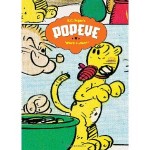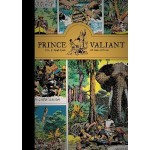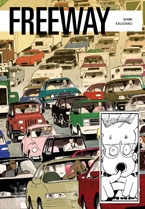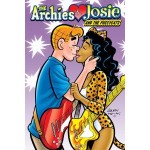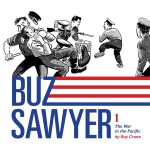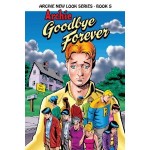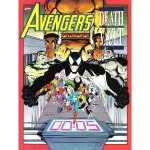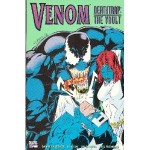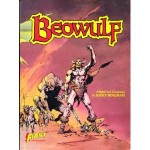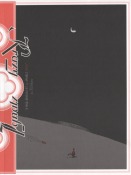
By George Herriman (Fantagraphics Books)
ISBN: 978-1-60699-364-4
I must admit to feeling like something of a fraud and an idiot reviewing George Herriman’s masterpiece of eternal unrequited love. Although Krazy Kat is unquestionably a pinnacle of graphic innovation, a hugely influential body of work which shaped the early days of the comics industry and an undisputed treasure of world literature, some readers – from the strip’s querulous beginnings in 1913 right up to this morning – just don’t “get itâ€. So those in the know are already fans (trust me; they just are) whilst those sorry few who are oblivious to the strip’s inimitable charms are beyond my meagre capacity to reach or help.
Still, since everyday there’s newcomers to the wonderful world of comics I’ll assume the missionary position once more and hope to catch and convert some fresh soul – or as I like to think of it save one more “lil Ainjilâ€â€¦
Krazy and Ignatz, as it is dubbed in these lovely collected tomes from Fantagraphics, is not and never has been a strip for dull, slow or unimaginative people who simply won’t or can’t appreciate the complex multilayered verbal and pictorial whimsy, absurdist philosophy or seamless blending of sardonic slapstick with arcane joshing. It is the closest thing to pure poesy that narrative art has ever produced.
Think of it as Dylan Thomas and Edward Lear playing “I Spy†with James Joyce amongst dry cactus fields whilst Gabriel GarcÃa Márquez types up the shorthand notes and keeps score…
Some brief background then: Herriman was already a successful cartoonist and journalist in 1913 when a cat and mouse that had been cropping up in his outrageous domestic comedy strip The Dingbat Family/The Family Upstairs graduated to their own feature. “Krazy Kat†debuted in William Randolph Hearst’s New York Evening Journal on Oct 28, 1913 and mainly by dint of the publishing magnate’s overpowering direct influence spread throughout his vast stable of papers.
Although Hearst and a host of the period’s artistic and literary intelligencia (which included e.e. Cummings, Frank Capra, John Alden Carpenter, Gilbert Seldes, Willem de Kooning, H.L. Mencken and Jack Kerouac) adored the strip many local editors did not and took every career-risking opportunity to drop it from the comics section. Eventually the feature found a home in the Arts and Drama section of Hearst’s papers. Protected by the publisher’s patronage the strip flourished unharmed by editorial interference and fashion and ran until Herriman’s death in April 1944.
The basic premise is simple: Krazy is an effeminate, dreamy, sensitive and romantic feline of indeterminate gender in love with Ignatz Mouse: rude crude, brutal, mendacious and thorougly scurrilous.
Ignatz is a real man; drinking, stealing, neglectful of his wife and children and spurns Krazy’s genteel advances by regularly hitting the cat with a well-aimed brick (obtained singly or in bulk from noted local brickmaker Kolin Kelly). A third member of the eternal triangle is lawman Offissa Bull Pupp, hopelessly in love with Krazy, well aware of the Mouse’s true nature, but bound by his own timidity and sense of honour from removing his rival for the cat’s affections. Krazy is blithely oblivious of Pupp’s dilemma…
Also populated with a stunning supporting cast of inspired anthropomorphic bit players such as Joe Stork, (deliverer of babies), the hobo Bum Bill Bee, Don Kiyoti, busybody Pauline Parrot, Walter Cephus Austridge, the Chinese mallard Mock Duck, Joe Turtil and a host of audacious characters – all capable of stealing the limelight and even supporting their own features – the episodes occur in and around the Painted Desert environs of Coconino (based of the artist’s vacation retreat Coconino County Arizona) and the surreal playfulness and fluid ambiguity of the flora and landscape are perhaps the most important member of the cast.
The strips are a masterful mélange of unique experimental art, strongly referencing Navajo art forms and sheer unbridled imagination and delightfully expressive language: alliterative, phonetically and even onomatopoeically joyous and compellingly musical (“He’s simpfilly wondafilâ€, “A fowl konspirissy – is it pussible?†or “I nevva seen such a great power to kookooâ€), yet for all that the adventures are poetic, satirical, timely, timeless, bittersweet, self-referential, fourth-wall bending, eerie, idiosyncratic and utterly hilarious escapades encompassing every aspect of humour from painfully punning shaggy dog stories to riotous slapstick.
There have been an absolute wealth of Krazy Kat collections since the late 1970s when the fondly remembered strip was generally rediscovered by a far more accepting audience and this particular compendium continues the complete year-by-year series begun by Eclipse and picked up by Fantagraphics when the former ceased trading in 1992. The current publisher’s avowed intent is to complete the collection and then keep the works in print and more power to them for that. This fabulous black and white volume Krazy & Ignatz: “A Kind, Benevolent and Amiable Brick†re-presents the years 1919-1921.
Within this magical atlas of another land and time the eternal game plays out as usual, but with some intriguing diversions such as recurring tribute’s to Kipling’s “Just So Stories†as we discover how the Kookoo Klock works, why bananas hang around in bunches and why Lightning Bugs light up; peer into the misty past to see Kwin Kleopatra Kat and Marcatonni Maus and explore the ever-changing seasons in a constant display of visual virtuosity and verbal verve…
Also included are fascinating articles and background features (‘A Mouse by any Other Name: Krazy and Ignatz’s Early Life Under the Stairs’ by Bill Blackbeard, ‘Geo. Herriman’s Los Angeles’ by Bob Callahan and the highly informative and instructional ‘Ignatz Mouse Debaffler Pages’), some intimate archival illustrations and photos and even unpublished and lost art.
Herriman’s epochal classic is a genuine Treasure of World Art and Literature and these comic strips have shaped our industry and creators, inspired creative auteurs in fields as disparate as prose fiction, film, dance, animation and jazz music and delivered delight and delectation to generations of devoted wonder-starved fans.
If however, you are one of Them and not Us, or if you actually haven’t experienced the gleeful graphic assault on the sensorium, mental equilibrium and emotional lexicon carefully thrown together by George Herriman from the dawn of the 20th century until the dog days of World War II, this latest glorious annotated compendium from Fantagraphics is one of the most accessible and certainly the most easily obtained book yet, so don’t waste this opportunity.
Just remember: not everybody gets it and some of them aren’t even stupid or soulless – they’re just unfortunate… “There Is A Heppy Lend Furfur A-Waayâ€â€¦
© 2011 Fantagraphics Books. All rights reserved.




